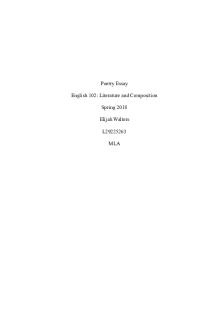Persuasive Essay - Grade: b PDF

| Title | Persuasive Essay - Grade: b |
|---|---|
| Author | HA HA |
| Course | Property Finance |
| Institution | Western Sydney University |
| Pages | 5 |
| File Size | 121 KB |
| File Type | |
| Total Downloads | 526 |
| Total Views | 1,055 |
Summary
Water, Sanitation and Hygiene in Third World CountriesWater, sanitation, and hygiene are critical elements in attaining high health standards in any community. People require clean and safe water for drinking and other domestic activities. According to UK Department for International Development (DI...
Description
Water, Sanitation and Hygiene in Third World Countries Water, sanitation, and hygiene are critical elements in attaining high health standards in any community. People require clean and safe water for drinking and other domestic activities. According to UK Department for International Development (DID) (1), about 900 million people worldwide lack access to safe and clean drinking water, mainly in developing countries. Inadequate supply of clean water leads to poor sanitations and hygiene that are associated with outbreaks of waterborne diseases such as cholera, among other infections that can lead to death (UNICEF 1). Lack of clean water supply coupled with poor sanitation and hygiene is a major challenge in the developing countries. Finding the causes of this problem would help in developing effective intervention to avail adequate clean and safe water that ultimately reduces diseases and promotes health standards. This paper argues that lack of funding affects water, sanitation, and hygiene in third world countries by causing low education and awareness levels, inadequate clean water supplies, and poor drainage systems. These elements are major contributors of health infections associated with water, and there is a need to solve the funding problem among developing states. The first argument: Limited funds contribute to development of insufficient clean water supply systems in developing nations, and can be overcome by increasing financial aid to affected nations. According to WHO (1), the developing countries do not have financial capability to provide clean water to the citizens, unlike the situation in developed nations. Third world states are characterized with large populations that would require extensive clean water supply systems. However, the countries are poor and have little budgets to allocate all areas of developments. Consequently, the governments allocate small budgets to water projects and hence do cannot supply all the citizens with clean and safe water. Developed water systems are found mainly in urban areas, which are inaccessible to communities in rural and remote places. Moreover, small towns and schools even lack tap systems to supply clean water from far distances, especially where there are no nearby water sources (Adams, Bartram, and Yves 5). Due to this, the third world countries do not satisfy the essential needs of clean water for the urban and rural inhabitants. The people are left to find sources of water for their consumption and resort to unsafe or untreated water such as wells, boreholes, rivers, or lakes. Some of these developing countries have water resources that require funds to exploit. For instance, water in lakes or rivers
requires purification and treatment in plants before supplying to the people. Also, the countries have underground water reservoirs that can be exploited by drilling boreholes wells, and setting purification plants and distributions systems (MIT 1). However, the available funds cannot install and maintain such systems. In some places where such projects are initiated, the systems lack sustainability due to low or absence of maintenance funds. Consequently, the projects fail and plunge the citizens into clean water shortages. The second argument: Lack of funds also contributes to poor drainage systems that lead to poor levels of sanitation and hygiene, and require increased financial aid to third world countries. Drainage systems are necessary to collect, dispose, or recycle used waters or limit the chances of flooding in low and flat area. Examples of drainage systems include sewerage lines and flooding waterways. These systems require huge funds to establish, maintain, and expand them to keep pace with changes in populations or environmental factors (UNDESA 1). However, the developing countries lack this much-needed capital that leads to poor and inadequate drainages. For example, the sewerage lines in urban areas do not expand with the growing population that leads persistent leakages, whereby sewage water flows in the open or near residential places. The sewage water from residential houses or industrial discharges end up in nearby water streams (UNEP 1). As a result, the water is polluted making it harmful for the downstream communities depending on the river as source for drinking water or human activities. Also, the polluted water is harmful to aquatic life. To overcome these sewerage problems, huge funds are needed to ensure all waste waters end to the collection points to allow safe disposal and recycling (UNEP 1). Besides the sewage leakages, the drainage systems cannot direct rainy waters and lead to flooding. Flood water mixes with sewerage and enters or covers some residential buildings. The cumulative effect of sewage along with flooded water is poor sanitation and hygiene that lead to outbreaks of waterborne diseases such as cholera, malaria, and hepatitis, among others. Therefore, lack of funds contributes significantly to sanitation and hygiene problems associated with poor drainage systems. The third argument: Limited funding leads to low levels of education and awareness on the need to access clean water and observe high hygiene and sanitation practices. Education is vital to enable communities observe healthy standards of living using the clean water and good sanitation. Funds are necessary to help promote levels of education and awareness. Communities
with greater awareness of the importance of the clean water and hygiene would strive to minimize consumption of unsafe water or living in unhygienic places (Adams, Bartram, and Yves 5). Creating this awareness requires funds to educate the children and communities, which gives skills to apply and lead healthy lives. However, the developing countries have limited funds that contribute to high illiteracy levels and unhealthy living conditions. Many groups do not know the health risks of using unsafe and clean water, especially in rural areas where safe tap water systems are unavailable (George 1). They do not preserve the water catchment areas and carry out activities that pollute them. Moreover, some communities hold on to their cultural practices that do not emphasis on the safety of water resources, consumption of clean water, or maintaining personal hygiene. For example, they do not have toilets or practice hand washing (UNICEF 1). Also, they do not have awareness to maintain their living environment clean. These poor living conditions can be altered by inculcating right ideas through education for all people. Children should be enrolled into schools while the adults receive awareness through campaigns. These activities require adequate funding to establish and maintain schools as well as ensuring all children can afford full education that prepares them to practice sanitation and hygiene throughout their lives. Education would also ensure there are many people with knowledge of the importance of clean water, sanitation and hygiene to lead others in transforming their cultures and developing clean water projects. In conclusion, this paper explored ways in which lack of funding influences water, sanitation and hygiene in developing countries. In particular, limited funds lead to inadequate clean water supply systems, poor drainages systems, and low education and awareness. Little safe water supply compels people to turn to untreated water for consumption. Poor drainage systems lead to sewerage leakages and flooding that cause outbreak of waterborne infections. Low education and awareness does not impart people with information and skills to ensure consumption of clean water and pursuit of healthy living conditions. The developed nations should increase funding to third world nations to enable their people access safe water besides observing high standards of hygiene and sanitation that promotes levels of health.
REFERENCES Adams, John, Jamie Bartram, Yves Chartier, and Jackie Sims. Water, Sanitation and Hygiene Standards for Schools in Low-cost Settings. WHO. 2009. http://www.who.int/water_sanitation_health/publications/wash_standards_school.pdf
George, Rose. Global issues in water, sanitation, and health: Workshop overview. 2009. http://www.ncbi.nlm.nih.gov/books/NBK28449/
MIT. Water Security in Developing Countries. n.d. http://12.000.scripts.mit.edu/mission2017/water-security-in-developing-countries/
UK DID. Policy paper: 2010 to 2015 government policy: water and sanitation in developing countries. Department for International Development. 2015. https://www.gov.uk/government/publications/2010-to-2015-government-policy-water-andsanitation-in-developing-countries
UNDESA. International decade for action “Water for Life” 2005-2015: Access to Sanitation. 2015. http://www.un.org/waterforlifedecade/
UNEP. Wastewater, Sewage and Sanitation. The Caribbean Environment Program. 2015. http://www.cep.unep.org/publications-and-resources/marine-and-coastal-issues-links/wastewatersewage-and-sanitation
UNICEF. Water, Sanitation and Hygiene. N.d. http://www.unicef.org/wash/
WHO. Water Sanitation Health: Costs and benefits of water and sanitation improvements at the global level. 2016. http://www.who.int/water_sanitation_health/wsh0404.pdf...
Similar Free PDFs

Persuasive Essay - Grade: B
- 3 Pages

Persuasive Essay - Grade: b
- 5 Pages

Persuasive Essay - Grade: A
- 3 Pages

Persuasive Essay - Grade: A+
- 6 Pages

Persuasive Essay - Grade: 98%
- 2 Pages

Persuasive Essay - Grade: A+
- 6 Pages

Rogerian Essay - Grade: B
- 2 Pages

Zoo Essay - Grade: B+
- 2 Pages

Causation Essay - Grade: B
- 4 Pages

Final Essay - Grade: B+
- 12 Pages

Propaganda Essay - Grade: b
- 4 Pages

Poetry Essay - Grade: B
- 5 Pages

Galileo Essay - Grade: B+
- 6 Pages

Fiction Essay - Grade: B
- 7 Pages

EPQ Essay - Grade: B+
- 10 Pages

Law essay - Grade: B
- 9 Pages
Popular Institutions
- Tinajero National High School - Annex
- Politeknik Caltex Riau
- Yokohama City University
- SGT University
- University of Al-Qadisiyah
- Divine Word College of Vigan
- Techniek College Rotterdam
- Universidade de Santiago
- Universiti Teknologi MARA Cawangan Johor Kampus Pasir Gudang
- Poltekkes Kemenkes Yogyakarta
- Baguio City National High School
- Colegio san marcos
- preparatoria uno
- Centro de Bachillerato Tecnológico Industrial y de Servicios No. 107
- Dalian Maritime University
- Quang Trung Secondary School
- Colegio Tecnológico en Informática
- Corporación Regional de Educación Superior
- Grupo CEDVA
- Dar Al Uloom University
- Centro de Estudios Preuniversitarios de la Universidad Nacional de Ingeniería
- 上智大学
- Aakash International School, Nuna Majara
- San Felipe Neri Catholic School
- Kang Chiao International School - New Taipei City
- Misamis Occidental National High School
- Institución Educativa Escuela Normal Juan Ladrilleros
- Kolehiyo ng Pantukan
- Batanes State College
- Instituto Continental
- Sekolah Menengah Kejuruan Kesehatan Kaltara (Tarakan)
- Colegio de La Inmaculada Concepcion - Cebu